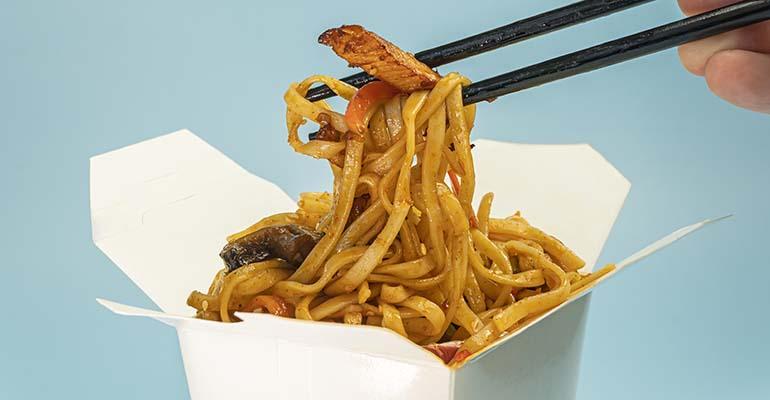Chinese food delivery has a long history in the U.S. There are more than 30,000 Chinese restaurants in America, a number that exploded around Nixon’s trip to China in the ’70s, but which has started to decline as the first-generation immigrants who created and ran these restaurants retire. Chinese food was one of the first foods to be delivered in America, and the Chinese takeout box is as synonymous with delivery as the pizza box.
With their long experience in profitable, consumer-loved delivery, these restaurants have a lot to teach the rest of the market about how to do delivery well. At the same time, new cuisine choices in delivery, courtesy of third-party marketplaces like DoorDash and UberEats, have made the delivery market more competitive for Chinese restaurants. While other cuisine types can learn from Chinese takeout, Chinese restaurants are also busily improving their game to compete with the relative newcomers.
The first advantage Chinese delivery has over third-party marketplaces is its profitability. Without several different parties (platform, driver, restaurant) involved in the transaction, Chinese restaurants have been able to profitably deliver food from restaurant to home at a reasonable price. What is the model that Chinese restaurants have so perfected that enables them to service the delivery market profitably?
Of course, good food consistently served is the basis for any great restaurant. No amount of business model adaptation or technology will fix lousy food. Chinese restaurants start with great food, and then make that food more easily accessible. Four major aspects make delivered Chinese food more profitable, efficient and effective as compared to other culinary categories’ current incremental approach through third-party marketplaces.
1. Delivery-centric kitchens
The dominant form of Chinese takeout restaurant is off-premises-first. Your favorite local Chinese restaurant may not have any tables at all. If it does, customers are rarely in them. The restaurant is often to be found in older real estate and is typically quite small — about 1,000 square feet. In many ways, these restaurants were the original “ghost kitchens.” This little delivery kitchen, designed primarily for the ordering and fulfillment of Chinese food, makes much more financial sense than a large, décor-heavy dine-in concept at Main on Main.
Other restaurant categories are starting to bifurcate into dine-in and off-premises prototypes. The dine-in-focused locations will do what they do best: create a great experience for guests choosing to go out for a meal. The off-premises-focused locations will increasingly do what they do best: innovate a better delivery experience.
Because Chinese takeout restaurants have always known the power of designing for off-premises, this is an advantage they carry forward over other restaurants who are “omnichannel” — or trying to be all things to all people. As more urban areas are redeveloped, Chinese takeout restaurants need to resist the urge to take on too many channels and too much complexity. They also need to fight to maintain their advantageous locations as their landlords redevelop their shopping centers.
2. Restaurants scaled to serve a tight delivery radius
Chinese takeout restaurants are cheaper to build and cheaper to operate than their dine-in peers. Because they are smaller and invest less in furniture, fixtures and equipment (FF&E), the upfront investment is low. Without a front-of-house to operate and clean, the labor costs are low. Together, these two factors enable profitability at lower average unit volumes (AUVs) than what a dine-in restaurant requires to succeed.
It’s critically important for Chinese takeout restaurants to succeed on lower AUVs. The delivery times need to be fast enough to fully utilize the drivers (more deliveries per hour) and to reduce the time between cooking and consumer (order-to-delivery time). “Windshield time” — time spent driving between pickup and dropoff — is wasted time. A tight delivery radius reduces windshield time. This tight delivery radius means the restaurant cannot rely on consumers who live or work 15-plus minutes away. With fewer consumers to drive sales, sales volumes can be lower than a large dine-in restaurant. The business has to be geared toward consumers who are a short drive away from the restaurant.
Again, Chinese restaurants have nailed this aspect of the delivery business. By designing for lower expected volumes, they can be profitable without millions of dollars in AUV. A recent innovation in the digital era has been to add cuisine types to the core Chinese restaurant through virtual restaurant brands. These brands increase the frequency of consumers who live within the existing delivery radius by offering nearby consumers more items to choose from vs. just Chinese food that they might order only once or twice a month.
3. First-party ordering first
Chinese food delivery had a head-start in delivery by many years. This means consumers had an ingrained ordering behavior that was direct to the restaurant, with no third party in between. While third-party ordering is an easy way to get online, and may drive incremental orders, it is critical that Chinese restaurants give its existing fans an easy way to order. This will keep first-party customers ordering first-party.
Because Chinese food delivery was invented before the internet, its ordering mechanics are through the telephone. Ask any American over the age of 50 how they grew up ordering Chinese food, and they will tell you they called. They may tell you they still do. Even back then, the phone call was highly efficient, focused on placing the order and confirming a rapid fulfillment time. Payment was originally cash on delivery.
Chinese delivery has innovated tremendously in the last 10 years to keep up with the Marketplaces. Companies like Beyond Menu, MenuSifu, WondersCo and ChowBus have seen great success bringing traditional Chinese restaurants into the smartphone era. Tso Chinese Delivery in Austin has created its own impressive technology to make the ordering, payment and fulfillment process as seamless as possible.
Ongoing innovation in online ordering and fulfillment is critical for Chinese food restaurants to not lose their incumbent advantage. Chinese restaurants must choose a tech platform that includes the triumvirate of great first-party ordering: integrated product ordering, payments, and loyalty. Going a step further with a holistic system that connects consumer demand to back of house capacity and driver availability creates a customer experience that beats third-party delivery.
4. Dedicated drivers
Delivery Chinese food establishments typically leverage dedicated drivers that are tied to specific restaurant locations. This driver pool increases availability, reduces delivery times, and enables batch delivery. It also prevents the broken hospitality chain inherent in a restaurant handing its food off to a driver who is employed by, managed by, and therefore responsible to… no one.
The challenge in Chinese food delivery is that historically drivers have often been family members — a cousin, an uncle, a son. As the second and third generation go into careers outside the restaurant industry, the pool of available drivers is shrinking. Going outside the family in the current labor environment can be difficult.
It seems much easier just to leverage the drivers on DoorDash, UberEats, or Relay and let these large, well-funded companies deal with finding enough drivers. The challenge is that using a third-party driver is expensive. The list price of most third-party deliveries is $6.99 per delivery. Most consumers will pay at most $4.99, leaving the restaurant $2 short.
New software, like Empower Delivery, can take away the effort of driver management by creating a gig working driver pool associated with the restaurant itself. Doing so reduces the inefficiencies and markups of using an outside driver while maintaining the “easy button” of a gig workforce.
Chinese food led the way in delivery for many years. These four advantages — design, location, direct ordering behavior, and dedicated drivers — are huge advantages. Technology designed exclusively for these delivery-centric restaurants can innovate these four advantages and ensure that Chinese takeout restaurants continue to lead in delivered food.
 AUTHOR BIO
AUTHOR BIO
Meredith Sandland and Carl Orsbourn are co-authors of “Delivering the Digital Restaurant: Your Roadmap to the Future of Food” and “Delivering the Digital Restaurant: The Path to Digital Maturity.” After each spent 20-plus years in corporate strategy and retail food, Meredith and Carl each concluded that food in America was changing. They left their corporate jobs in search of innovation that would transform the restaurant industry. Ghost kitchens, virtual brands, digital marketing, the gig economy and lean operations are at the heart of the future they envision. Carl is the COO of Juicer, a restaurant dynamic pricing company. Meredith is the CEO of Empower Delivery, software that powers delivery-centric kitchens. Subscribe to their newsletter and podcast at deliveringthedigitalrestaurant.com.





